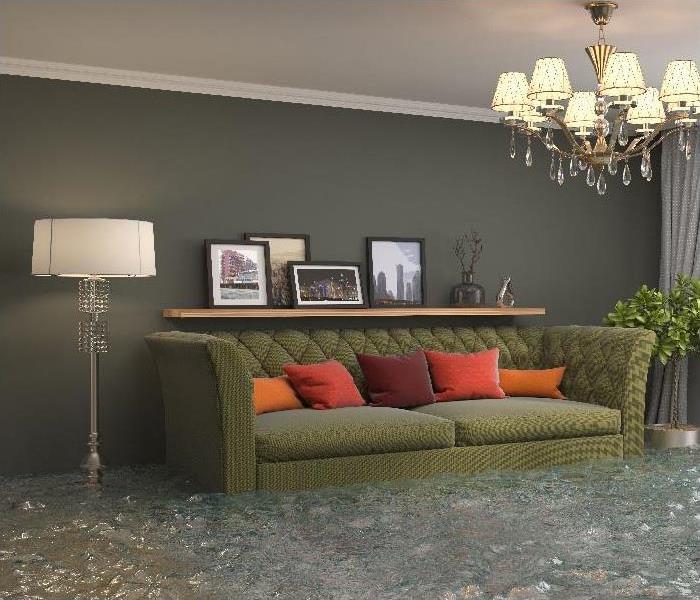What Are the Long Term Consequences If You Wait to Do Flood Damage Restoration in Daytona Beach?
4/24/2020 (Permalink)
 Do not delay contacting SERVPRO of North Daytona Beach / Ormond Beach if seasonal storm damage results in flooding to your residence.
Do not delay contacting SERVPRO of North Daytona Beach / Ormond Beach if seasonal storm damage results in flooding to your residence.
Count on Fast and Reliable Response for the Daytona Beach Community When SERVPRO Assists with Severe Storm or Hurricane Flood Damage
Even if you had a few hours to days to anticipate your risk of residential flooding due to a pending weather pattern, responding to the issues outside and inside your house after the storm or hurricane hits might be significantly different than your theoretical musings. Perhaps you are a newer resident, or you have dodged severe damage in the past. If you have experienced flood loss before you might feel you are ready for anything, but the reality, unfortunately, can be different.
What Do Professionals Suggest Preliminary Tasks Should Include?
Some general predictions about flood damage in Dayton Beach share a community experience of the aftermath. It is not uncommon that at least the lower levels of your home are likely filled with mud, silt, and contaminated water, perhaps including saltwater storm surge. Some level of exterior damage is typical, from high winds, falling trees, flying debris, and floodwater pressure. If basic attempts to make your home safer and ready for more thorough assessment fail to happen quickly, the overall damage and ultimate expense of restoration will increase. Here are baseline tasks you cannot delay:
• Exterior holes, including roof, window, door, and siding damage, need board and tarp up services.
• A walk-through to identify safety hazards such as weakened structural supports, ceiling, and floors is crucial to avoid injury or worse for occupants and others.
• Shut off of utilities, especially electricity and gas lines, protects against electrocution or shock and possible fires.
Why Should Professionals Handle Some or All of the Safety and Security Steps?
Securing your home might require the installation of large sheets of plywood, management of broken glass and damaged building materials, and even the design and building of structural supports. These tasks are not one-person jobs, and best practices recommend proper materials and tools are used, and training and experience support the methods employed. SERVPRO crews are graduates of the Institute of Inspection Cleaning and Restoration Certification (IICRC) training courses in a broad range of certifications vital to performing flood damage mitigation and remediation appropriately. We count a robust rebuilding division among our in-house resources, skilled workers dedicated to helping our customers when needed.
Is It Dangerous to Work with Flood Waters?
Floodwaters are characterized as Category 3, severely and possibly dangerously contaminated water. They can contain everything and every combination of bio and other hazards from dead animals to sewage to industrial waste to chemicals to asbestos or lead. The longer the contaminated fluids stand and flow through your home, the more opportunities you and your family face for exposure to the risks of health-related issues and injury. At the same time, the building materials in your house encounter and suffer from the persistent corrosive effects of water, possibly including saltwater.
How Do Professionals Protect Themselves and Customers from Contaminated Water?
Our crews wear personal protective equipment (PPE) and also consider containment of work areas as an added precaution. If we partition damaged areas for containment purposes, we seal off the workspace with six mil polyethylene and install an air scrubber that uses HEPA technology to filter the air.
Is It Best Practice to Remove Contaminants and Water Fast?
Waiting to deal with the toxic mix of floodwaters and all the possible contaminants permit the proliferation of pathogens, including molds. Mold growth damages structure and can cause health effects for susceptible individuals. The delay means more risk of irritations and allergic reactions for occupants and progressive damage to building materials. Taking care of the floodwaters promptly avoids secondary damage and more disruption and expense.
Why Is Air-Quality Management Important During Flood Mitigation and Remediation?
The wide variety of pathogens and other biohazards disturbed during flood water removal and drying exists in both the water and the atmosphere in the work areas. Airborne lead and asbestos, for example, might become part of the challenge if we cut away building materials to release water, and we encounter asbestos insulation or lead-painted walls.
If Controlled Demolition Is Done During Water Removal and Drying, Do I Need to Line Up a Rebuilding Company?
We help with mitigation, remediation, and restoration services for our customers. We strive to streamline the repair and rebuilding process. Among our employees also are certified mold remediators for the State of Florida, allowing us to design a fungal remediation response following the Environmental Protection Agency (EPA) protocol in the event mold grows during the 24 to 48-hour window expected for this complication. Our biohazard license allows us to manage other hazardous substances discovered or dislodged during flood remediation.
Do not delay contacting SERVPRO of North Daytona Beach / Ormond Beach if seasonal storm damage results in flooding to your residence. We answer inquiries 24/7 at (386) 677-9993, ready to roll within hours to assess your circumstances and plan an efficient response.
For more about Daytona Beach click here.






 24/7 Emergency Service
24/7 Emergency Service